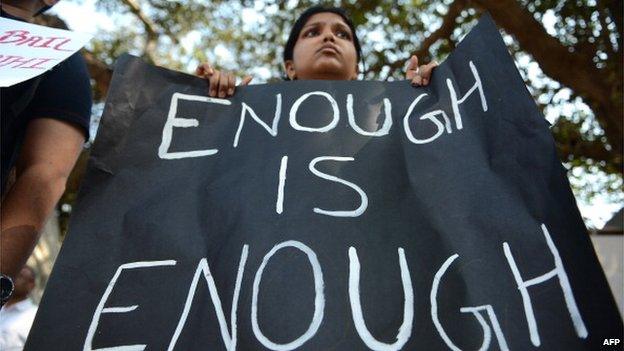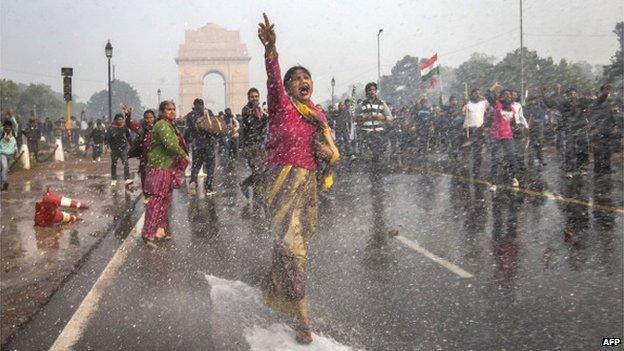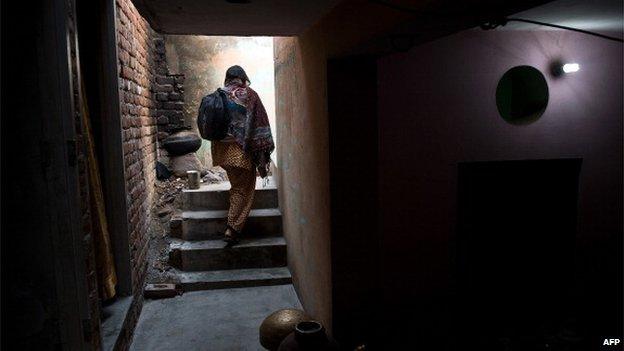Viewpoint: How a rape changed India
- Published

The Delhi rape incident prompted unprecedented levels of protest and outrage against sexual violence on the streets of the Indian capital
The fatal gang rape of a 23-year-old student inside a bus in Delhi last December caused international outrage and prompted India to introduce stringent anti-rape laws. Author and journalist Nilanjana S Roy considers how the shocking case changed the country.
Coughing from the tear gas, shivering because the last round of spray from the water cannons had caught her full force, the college student who had stumbled out from the knot of demonstrators at Raisina Hill, external said, in between her retching: "They don't get it."
This was on the first day of the protests in Delhi last December, which saw thousands of people - many of them students - come to Raisina Hill to ask their government for justice.
The woman who had sparked the protests was dead. She had gone to see The Life of Pi at a mall in the affluent Delhi neighbourhood of Saket; she and her male friend had taken a bus back home, and never reached her destination.
Widening gap
The four men on that bus had attacked the couple, beaten the man savagely, raped the young woman and left her to die from her injuries, which were brutal and which had been inflicted on her over the unimaginably long course of an hour. The bus went through several police checkpoints, unchallenged.
The student coughed hard and said again, gesturing at the impassive sandstone buildings of North and South Block, the seat of government power in New Delhi: "They don't get it. None of their children use buses. They don't understand what we want."
She was wearing a Tommy Hilfiger jacket, a cheap knock-off that looked close to the original, and smart Converse sneakers. She came from a college on the outskirts of Delhi, and knew something about the lives of those in her generation who didn't have access to privilege, power, the insulation provided by cars and drivers or enough pocket money to cover the cost of taxis.
Over the next year, the distance between the people demonstrating on the roads that day and the many institutions of power would widen until the gap seemed more like an abyss.

The Delhi protests were unusual for a 'city indifferent to violence against women'
The demonstration in Delhi was not unusual because it brought women out into public spaces to protest against the everyday, casual violence that they faced in large parts of India. (In October that year, women in the neighbouring state of Haryana had howled their anger at the police, and recited their experiences of assault and violence, protesting against the rising incidence of rape in the state and the apathy of those in government.)
It was unusual because the students who stood there in the freezing weather, brushing away the TV cameras, were speaking for a city famous for its indifference and for the harassment and violence women, in particular, faced on its streets. They were there to say "enough", to demand, as so many hand-made placards put it, not protection but freedom.
That was what they sang for the next few months as they wound through college campuses and through the bus route from Saket -an old protestor's chant about azaadi, freedom.
Kavita Krishnan, one of the faces of the Delhi protests, put it best in December: "We do not want to hear this defensive argument that women only leave their homes for work, poor things, what can they do, they are compelled to go out. We believe that regardless of whether she is indoors or outside, whether it is day or night, for whatever reason, however, she may be dressed - women have a right to freedom. And that freedom without fear is what we need to protect, to guard and respect."
Fierce pushback
Over the next few months, that chant was heard often. From the world, we want freedom. In our homes, freedom. On the streets, freedom. In our bedrooms, freedom. Everywhere, freedom.
The pushback after the protests were fierce, almost immediate.
From politicians, religious leaders and even police officers, there was a rush of comments with the same thrust. Rapes were rising because women wanted too much freedom; because of the clash between old, traditional cultures and these new, Westernised attitudes; because women wore the wrong clothes, went out "dented and painted" to the wrong places, did not respect limits.
Early in the new year, the Justice Verma Commission filed a report on women's safety that was a stirring manifesto demanding a long-delayed equality.
Rape had nothing to do with honour; institutions that were supposed to uphold law-and-order often protected the perpetrators of sexual assault; the Indian Penal Code, external was often patriarchal, putting women and the lesbian, gay, bisexual and transgender (LGBT) community on a less than equal footing. The reforms they suggested were concrete, detailed plans of action. When journalist Namita Bhandare put out a Stop Rape Now! petition, asking supporters to back the Verma Commission, she received 319,000 signatures.

The voice of protestors against violence against women has 'remained strong'
The report was buried, as so many other demands for institutional change would be ignored or pushed aside over the year. The demand that marital rape be made a crime was turned down by parliament, on the grounds that this might destabilize the Indian home and family; an attempt to bring politicians to account if they had rape or sexual assault charges against them, as many did, was stalled; and so it went.
The institutions of power did what they had done back in December: they sealed themselves into their own bubble world, ignoring what was happening outside their doors.
But that December, something else had changed, and that had very little to do with the state, or even with the laws. The protests slowed, and the demonstrations gradually wore themselves down, but the voices of the protestors remained strong.
The first signs of change began to show in the media, as issues once considered "women's issues" and relegated to the inside pages became mainstream on TV shows, and as the country began to discuss sexual violence across caste and class lines as well.
In Delhi and elsewhere across the country, a sense of solidarity among women, progressive men, and the LGBT community had begun to grow; a new set of connections and networks had formed organically.
Speaking up
These issues - a questioning of the old, rigid, patriarchal norms, the demands for freedoms and for equality rather than for safety and protection - united women and men across class lines, and across regional lines, if not quite across caste lines.
Where there had been a few feminist voices speaking in the mainstream, there was now a score of women: students, lawyers, activists, housewives, people brought together only by a common belief that it was time to change the way we lived.
Behind that score, there were hundreds more. Some, like Kavita Krishnan, had always been part of the women's movement and the larger push for equality; some, like Namita Bhandare, sharpened their activist selves for the first time in December; some, like the journalists Neha Dixit, Rukmini Shrinivasan, Nisha Susan, Lakshmi Chaudhury and many others, discovered both their voices and the platforms that would allow them to speak for the rest of us.

India has a 'rights problem' when it came to the condition of women
When the Supreme Court handed down a regressive, dismaying judgement on 11 December, re-criminalising sexual activities "against the order of nature", including homosexual acts, the dismay and anguish among the LGBT community swiftly rippled outwards. As had happened all along this painful year of demanding an end to the ways in which we allowed and enabled kinds of violence and inequality, another major Indian institution had let us down, speaking in the calcified voice of tradition and patriarchy.
But something had changed in the air of urban India, and definitely in Delhi.
Within a few hours of the judgement being released, the first calls for protest and for change had begun. As had happened in December 2012, the calls were for justice, and for equality, and for the right for all citizens, women, members of the LGBT community, to live without fear, and with dignity. They rippled out across a wide, loose coalition of men and women, people who had come together first to mourn and to share their anger.
The problem did not lie with the rape figures; they never had, and in statistical terms, India had no more of a "rape problem" than many Western countries, including the US. India had a rights problem, and the Verma Commission had seen it when it had asked for a second freedom movement, for women.
A year down the line, that chant had not been subdued by the uneasy response from institutions, or by the resistance from many officials and politicians.
In their personal lives, in their sexual choices, in their right to be treated with respect at workplaces, to move without fear on the streets, it was this azaadi, this freedom, that a new generation of Indians were determined to claim.